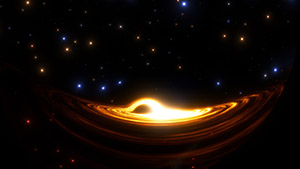
Contact Us
Institutional Communications
Bureau of Mines Building, Room 137
Laramie, WY 82071
Phone: (307) 766-2929
Email: cbaldwin@uwyo.edu
UW Planetarium May Schedule Includes Black Hole, Science Fiction Programs
Published April 30, 2019

This 3-D model of the dusty disk around a black hole is remarkably similar to the
first image of a black hole from the Event Horizon Telescope. The UW Harry C. Vaughan
Planetarium presents “Humanity’s First Picture of a Black Hole” Friday, May 24, at
8 p.m. (UW Planetarium Photo)
A program on the first image ever of a black hole and a couple of programs focusing on science fiction will highlight offerings at the University of Wyoming Harry C. Vaughan Planetarium during May.
“May brings us warmer weather and the start of summer. Join us in exploring our summer skies, vacationing around the solar system, finding alien planets, learning the science of science fiction and creating the cosmic calendar,” says Jordan Turner, the planetarium’s interim coordinator. “And don't miss out on the show about the biggest astronomy news of the year -- the first image of a black hole.”
Friday night shows start at 8 p.m., and STAR Observatory tours run from 9-10 p.m. Kid-themed planetarium shows are Saturdays at 11 a.m. The month also includes two Tuesday night shows; they begin at 7 p.m.
Tickets are $3 for students and $4 for nonstudents. Tickets can be purchased at the Department of Physics and Astronomy main office, located in Room 204 of the Physical Sciences Building, Monday through Thursday, from 8 a.m.-4:30 p.m., and Friday from 8 a.m.-noon. Tickets also can be purchased by going online at http://wyomingspacegrant.org/planetarium/shows/ and clicking on “Purchase tickets online with a credit card.” Doors open 20 minutes before the show, where tickets will be sold if available. The planetarium, which seats 58, is located in the basement of the Physical Sciences Building.
The May planetarium schedule is as follows:
-- “Science Fiction in Star Wars,” Friday, May 3, 8 p.m. May the Fourth be with you! This program will take an in-depth look at the science (or fiction) of various phenomenon in the Star Wars universe. The STAR Observatory on the rooftop of the Physical Sciences Building will be open to the public for a “star party” from 9-10 p.m. Weather permitting, telescopes will be set up to peer into the evening sky.
-- “This Month’s Sky,” Tuesday, May 7, 7 p.m. May brings warmer weather, new constellations and good stargazing. Mars, a meteor shower and a blue moon are just a few cool celestial events to look out for.
-- “Eyes Up, Everyone,” Friday, May 10, 8 p.m. Nothing is quite like being out under the stars, whether you know all of the constellations or not. But with camping season fast approaching, it is time to brush up on the kings, heroes and gods in the sky during the summer season. Visitors can join in around the virtual campfire and explore the summer sky.
-- “Solar System Vacation Destination,” Saturday, May 11, 11 a.m. This show explores each of the planets in the solar system, their climates and weather, and which planet would make the best vacation destination.
-- “Out There: The Quest for Extrasolar Worlds,” Tuesday, May 14, 7 p.m. We are able to explore more and more of the universe. What we have found so far has surpassed even our wildest expectations, as there are planets everywhere.
-- “The Science of Science Fiction,” Friday, May 17, 8 p.m. From “Star Trek” to “Star Wars,” from books to movies to video games, sci-fi is a gigantic genre. This program explores why bionics, robots, teleportation and Asgardian magic are all rooted in reality. The STAR Observatory on the rooftop of the Physical Sciences Building will be open to the public for a “star party” from 9-10 p.m. Weather permitting, telescopes will be set up to peer into the evening sky.
-- “Humanity’s First Picture of a Black Hole,” Friday, May 24, 8 p.m. Humanity was treated to the awe-inspiring first image of a black hole April 10. This show will review the science behind black holes and the technology used to create this incredible image.
-- “The Entire History of the Universe,” Friday, May 31, 8 p.m. The universe began with the Big Bang nearly 14 billion years ago. But, what all has happened between then and now? This show will condense the entire history of the universe into one calendar year to create the cosmic calendar -- beginning at midnight Jan. 1 with the Big Bang and ending with present day at 11:59 p.m. Dec. 31.
For more detailed descriptions of these programs, go to www.wyomingspacegrant.org/planetarium/shows/.
Contact Us
Institutional Communications
Bureau of Mines Building, Room 137
Laramie, WY 82071
Phone: (307) 766-2929
Email: cbaldwin@uwyo.edu
